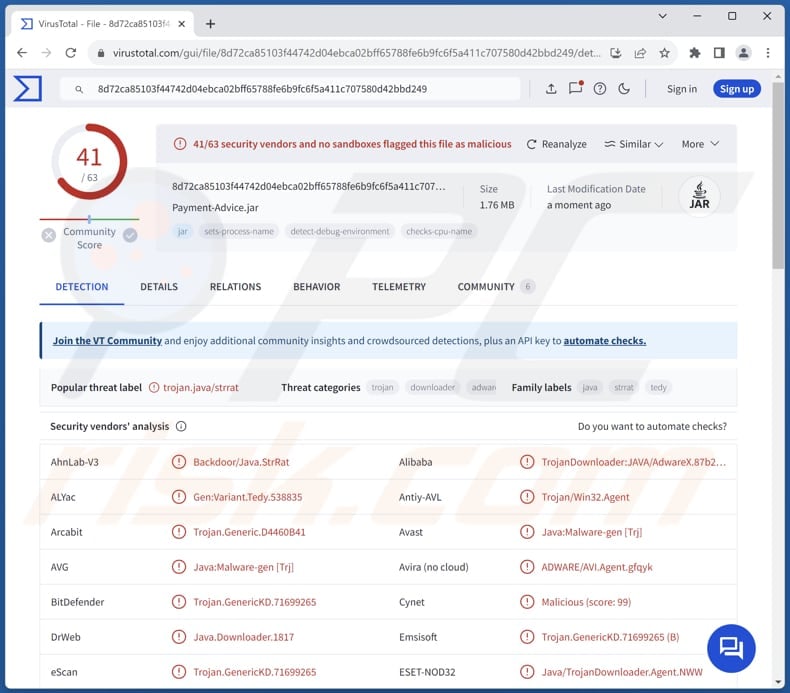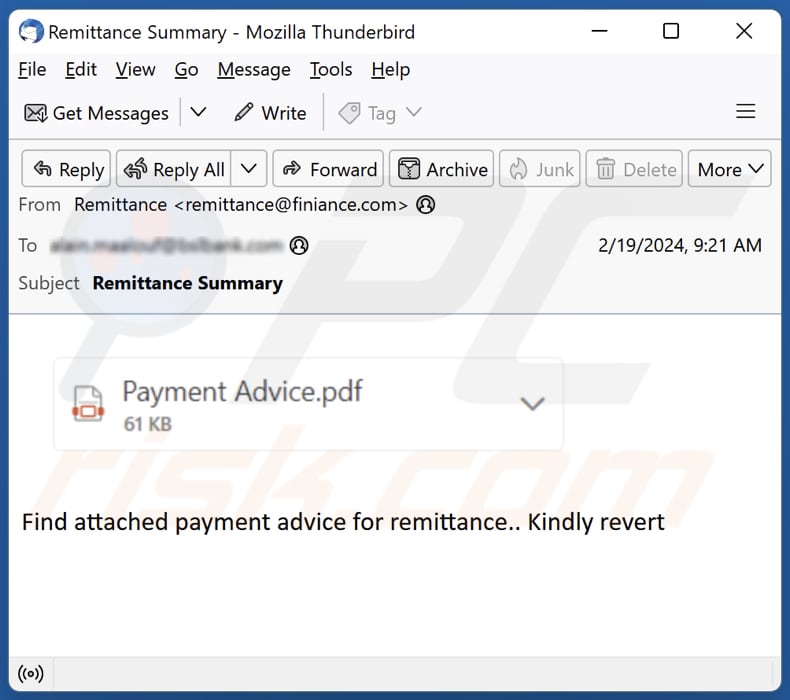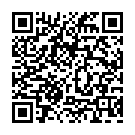How to eliminate VCURMS malware
![]() Written by Tomas Meskauskas on (updated)
Written by Tomas Meskauskas on (updated)
What kind of malware is VCURMS?
VCURMS is a remote administration Trojan (RAT) that cybercriminals store on public services such as Amazon Web Services (AWS) and GitHub. This method allows the Trojan to conceal its presence and activities from security measures, making it more challenging to detect and remove from infected systems.

More about VCURMS
VCURMS employs email as its means of command and control, utilizing Proton Mail for enhanced privacy and secure communication with the compromised endpoint. During its setup process, the malware duplicates itself into the Windows Startup folder to guarantee automatic activation when the system boots up.
Upon receiving directives from the attacker, VCURMS identifies the victim by extracting details such as the computer name and Volume ID. It meticulously examines both the subject line and body of the email to authenticate the received command. Furthermore, the malware hosts keylogger and password recovery modules on AWS, camouflaged with .jpg extensions, and retrieves them using PowerShell commands.
Upon receiving the "recovery" command, VCURMS initiates the download and installation of an information stealer. This stealer is primarily focused on extracting sensitive information from the victim's system. It targets a wide array of data, including system details such as network and hardware information, as well as specific information from popular applications and browsers.
The targeted applications include Discord and Steam, while the browsers encompass a comprehensive list, including Brave, Chrome, Edge, Firefox, Opera, OperaGX, Vivaldi, and Yandex. The program aims to harvest various types of data from these applications and browsers, ranging from account information to browsing history and stored passwords.
This includes cookies, autofill data, and other browser-related information, providing the attacker with a wealth of sensitive data about the victim's online activities and accounts.
VCURMS can execute additional commands to obtain a wide range of system details, including the operating system version, memory capacity, computer name, volume ID, username, country, and files stored in the Desktop and Documents folders. It can also undertake additional actions related to a keylogger and a data stealer component.
| Name | VCURMS remote access trojan |
| Threat Type | Remote Access Trojan, Keylogger, Information Stealer |
| Detection Names | Avast (Java:Malware-gen [Trj]), Combo Cleaner (Trojan.GenericKD.71699265), ESET-NOD32 (Java/TrojanDownloader.Agent.NWW), Kaspersky (HEUR:Trojan.Win32.Generic), Microsoft (Adware:AndroidOS/Multiverze), Full List (VirusTotal) |
| Symptoms | Remote Administration Tojans are designed to stealthily infiltrate the victim's computer and remain silent, and thus no particular symptoms are clearly visible on an infected machine. |
| Distribution methods | Infected email attachments, malicious online advertisements, social engineering, software 'cracks'. |
| Damage | Stolen passwords and banking information, identity theft, monetary loss, hijacked online accounts, and more. |
| Malware Removal (Windows) | To eliminate possible malware infections, scan your computer with legitimate antivirus software. Our security researchers recommend using Combo Cleaner. |
Possible damage
Victims of VCURMS may encounter severe repercussions due to the malware's intrusive capabilities. The theft of sensitive information, including system details and personal data from popular applications and browsers, can lead to identity theft, financial loss, and compromised online accounts.
Moreover, the presence of a keylogger component puts victims at risk of having their keystrokes monitored, potentially exposing confidential information such as passwords, credit card details, and other sensitive credentials. These consequences underscore the urgent need for robust cybersecurity measures to detect and mitigate the impact of such malicious threats.
It is worth noting that VCURMS is associated with another RAT called STRRAT.
How did VCURMS infiltrate my computer?
The VCURMS malware is being spread through a phishing campaign that tricks people into downloading a malicious Java downloader. This downloader helps to spread the VCURMS remote access Trojan. The malware is stored on public services such as Amazon Web Services (AWS) and GitHub.
The phishing emails ask recipients to verify their payment information by clicking a button. This leads to the download of harmful JAR files hosted on AWS. These files look like typical attachments, but they actually contain code that downloads and executes additional JAR files provided by the attacker.
How to avoid installation of malware?
Maintain regular updates for your operating systems, applications, and antivirus software. Always verify the authenticity of emails before interacting with any attachments or links they contain. Be cautious of downloading software or files from unreliable sources, such as peer-to-peer networks or suspicious websites.
Prioritize official websites or app stores for downloads, avoiding the use of pirated software. Exercise caution when encountering pop-ups and ads on questionable sites. Enhance your security measures by utilizing a reputable security tool for added protection against potential threats.
If you believe that your computer is already infected, we recommend running a scan with Combo Cleaner Antivirus for Windows to automatically eliminate infiltrated malware.
Malicious attachment distributing VCURMS ("Payment Advice.pdf"):

Text in the email:
Subject: Remittance Summary
Find attached payment advice for remittance.. Kindly revert
Instant automatic malware removal:
Manual threat removal might be a lengthy and complicated process that requires advanced IT skills. Combo Cleaner is a professional automatic malware removal tool that is recommended to get rid of malware. Download it by clicking the button below:
▼ DOWNLOAD Combo Cleaner
By downloading any software listed on this website you agree to our Privacy Policy and Terms of Use. To use full-featured product, you have to purchase a license for Combo Cleaner. 7 days free trial available. Combo Cleaner is owned and operated by Rcs Lt, the parent company of PCRisk.com read more.
Quick menu:
How to remove malware manually?
Manual malware removal is a complicated task - usually it is best to allow antivirus or anti-malware programs to do this automatically. To remove this malware we recommend using Combo Cleaner Antivirus for Windows.
If you wish to remove malware manually, the first step is to identify the name of the malware that you are trying to remove. Here is an example of a suspicious program running on a user's computer:

If you checked the list of programs running on your computer, for example, using task manager, and identified a program that looks suspicious, you should continue with these steps:
 Download a program called Autoruns. This program shows auto-start applications, Registry, and file system locations:
Download a program called Autoruns. This program shows auto-start applications, Registry, and file system locations:

 Restart your computer into Safe Mode:
Restart your computer into Safe Mode:
Windows XP and Windows 7 users: Start your computer in Safe Mode. Click Start, click Shut Down, click Restart, click OK. During your computer start process, press the F8 key on your keyboard multiple times until you see the Windows Advanced Option menu, and then select Safe Mode with Networking from the list.

Video showing how to start Windows 7 in "Safe Mode with Networking":
Windows 8 users: Start Windows 8 is Safe Mode with Networking - Go to Windows 8 Start Screen, type Advanced, in the search results select Settings. Click Advanced startup options, in the opened "General PC Settings" window, select Advanced startup.
Click the "Restart now" button. Your computer will now restart into the "Advanced Startup options menu". Click the "Troubleshoot" button, and then click the "Advanced options" button. In the advanced option screen, click "Startup settings".
Click the "Restart" button. Your PC will restart into the Startup Settings screen. Press F5 to boot in Safe Mode with Networking.

Video showing how to start Windows 8 in "Safe Mode with Networking":
Windows 10 users: Click the Windows logo and select the Power icon. In the opened menu click "Restart" while holding "Shift" button on your keyboard. In the "choose an option" window click on the "Troubleshoot", next select "Advanced options".
In the advanced options menu select "Startup Settings" and click on the "Restart" button. In the following window you should click the "F5" button on your keyboard. This will restart your operating system in safe mode with networking.

Video showing how to start Windows 10 in "Safe Mode with Networking":
 Extract the downloaded archive and run the Autoruns.exe file.
Extract the downloaded archive and run the Autoruns.exe file.

 In the Autoruns application, click "Options" at the top and uncheck "Hide Empty Locations" and "Hide Windows Entries" options. After this procedure, click the "Refresh" icon.
In the Autoruns application, click "Options" at the top and uncheck "Hide Empty Locations" and "Hide Windows Entries" options. After this procedure, click the "Refresh" icon.

 Check the list provided by the Autoruns application and locate the malware file that you want to eliminate.
Check the list provided by the Autoruns application and locate the malware file that you want to eliminate.
You should write down its full path and name. Note that some malware hides process names under legitimate Windows process names. At this stage, it is very important to avoid removing system files. After you locate the suspicious program you wish to remove, right click your mouse over its name and choose "Delete".

After removing the malware through the Autoruns application (this ensures that the malware will not run automatically on the next system startup), you should search for the malware name on your computer. Be sure to enable hidden files and folders before proceeding. If you find the filename of the malware, be sure to remove it.

Reboot your computer in normal mode. Following these steps should remove any malware from your computer. Note that manual threat removal requires advanced computer skills. If you do not have these skills, leave malware removal to antivirus and anti-malware programs.
These steps might not work with advanced malware infections. As always it is best to prevent infection than try to remove malware later. To keep your computer safe, install the latest operating system updates and use antivirus software. To be sure your computer is free of malware infections, we recommend scanning it with Combo Cleaner Antivirus for Windows.
Frequently Asked Questions (FAQ)
My computer is infected with VCURMS malware, should I format my storage device to get rid of it?
Formatting your storage device will remove the VCURMS malware from your computer, but it is an extreme measure with significant consequences. Formatting will erase all data stored on the device, including your files, programs, and operating system. Before resorting to formatting, consider using reputable antivirus software to scan and remove the malware.
What are the biggest issues that malware can cause?
The biggest issues that malware can cause include data theft, system damage, file encryption, financial losses, and compromised privacy.
What is the purpose of VCURMS RAT?
VCURMS malware is designed to infiltrate systems, gather sensitive information, and grant remote access to cybercriminals. Its capabilities include extracting various system details, capturing keystrokes, and stealing data from popular applications and browsers. VCURMS facilitates ongoing communication with attackers via email, enabling them to issue commands and receive stolen data securely.
How did VCURMS infiltrate my computer?
VCURMS spreads through a phishing campaign, where users are tricked into downloading a malicious Java downloader, aiding in the distribution of the VCURMS remote access Trojan. The malware is stored on public services like Amazon Web Services (AWS) and GitHub. Deceptive emails used in this campaign prompt recipients to verify payment information by clicking a button, initiating the download of harmful JAR files from AWS.
Will Combo Cleaner protect me from malware?
Cleaning malware often requires a comprehensive system scan to detect and remove all malicious components, including those that are hidden. Combo Cleaner is capable of identifying and removing most known malware infections.


▼ Show Discussion